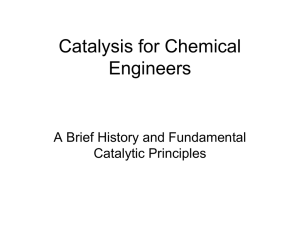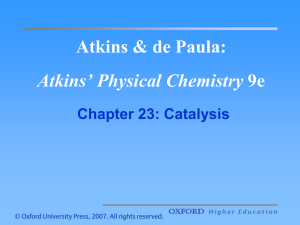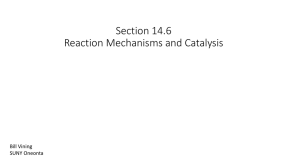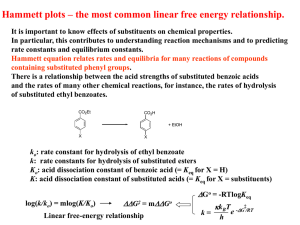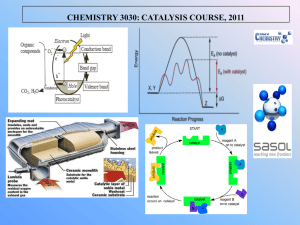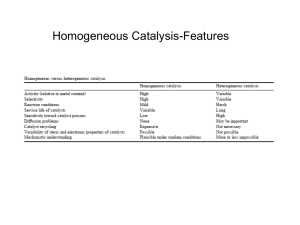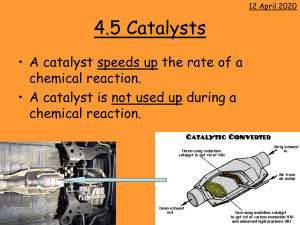Heterogeneous catalysis and solid
advertisement
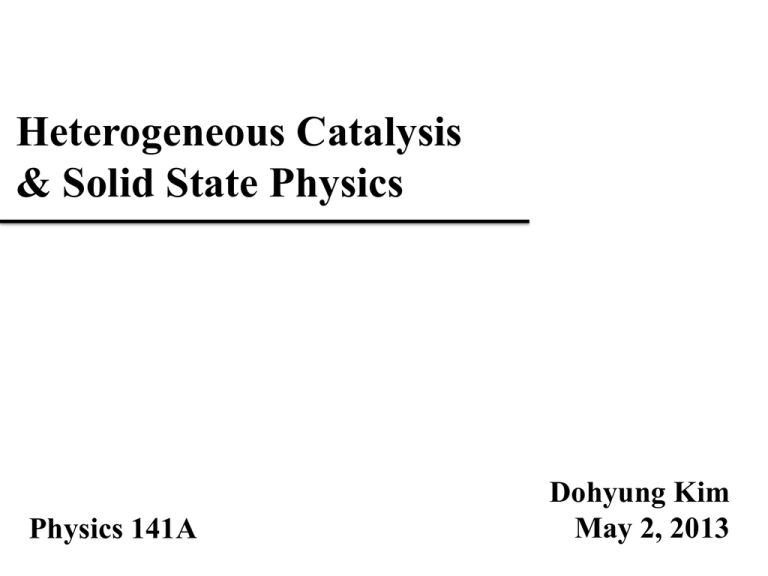
Heterogeneous Catalysis & Solid State Physics Physics 141A Dohyung Kim May 2, 2013 Catalysis Catalysis : Increase in the rate of reaction due to a catalyst <http://www.chemguide.co.uk > Types of Catalysts 1) Homogeneous : Catalyst and Reactant in the same phase 2) Heterogeneous : Catalyst and Reactant in different phases Catalysis Types of Catalysts 1) Homogeneous : Catalyst and Reactant in the same phase e.g.) Organometallic Compounds <Cativa Process> 2) Heterogeneous : Catalyst and Reactant in different phases e.g.) Metal Surface <Catalytic decomposition of formic acid on noble metals> <International Journal of Hydrogen Energy Volume 37, Issue 21, 2012, 15956 - 15965> Heterogeneous Catalysis Elementary steps in heterogeneous catalysis ① Adsorption of reactants ③ Desorption of products ② Reaction of adsorbed intermediates Adsorptive property of a catalyst = Catalytic activity D-band Model(Chemisorption) Electronic structure of transition metal Interaction between energy levels Adsorbate Adsorbate Broad band Narrow band D-band Model(Chemisorption) Formation of a chemical bond Antibonding Bonding <A. Nilsson et al., Chemical Bonding at Surfaces and Interfaces, Elsevier(2008)> Strong vs Weak chemisorption Ed - EF <B. Hammer et al., Advances in catalysis, Vol. 45(2000), 71-129> D-band Model(Chemisorption) Variation in adsorption energies 1) Different Metal catalysts ΔE(eV) <B. Hammer et al., Advances in catalysis, Vol. 45(2000), 71-129> # of d-electrons Ed - EF D-band Model(Chemisorption) Variation in adsorption energies 2) Different Facets ex) FCC Band Width(W) ~ sqrt(N) Decreasing Atomic Density <A. Nilsson et al., Chemical Bonding at Surfaces and Interfaces, Elsevier(2008)> <B. Hammer et al., Catalysis Letters, 46(1997), 31-35> D-band Model(Chemisorption) Variation in adsorption energies 3) Alloying <J. R. Kitchin et al., J. Chem. Phys. 120, 10240 (2004)> Control of reactivty through catalyst deposition <A. Nilsson et al., Chemical Bonding at Surfaces and Interfaces, Elsevier(2008)> Volcano Curve Plot of reaction rate vs property of a catalyst (e.g. Heat of adsorption) → Volcano Shape Sabatier Principle : The interaction between the catalyst and the substrate should be “just right” * Case of decomposition of formic acid on transition metals <Karl Kochloefl (2005), "Heterogeneous Catalysis and Solid Catalysts“> Activity related to various properties of a catalyst, mostly bulk properties. The most fundamental parameter ? Bronsted-Evans-Polanyi(BEP) relation Linear relationship between the activation energy and dissociative chemisorption energy Ea(=Ets) = aΔE + b A2 + 2 * ↔ 2 A* <Shengguan Wang et al., SLAC-PUB-14285> Ea A2 + 2 * Dissociative chemisorption energy determines the catalytic activity ! ΔE 2 A* Simple Kinetic Models A2 + 2B ↔ 2AB ① Dissociative adsorption as RDS without strongly adsorbed A2 ② Dissociative adsorption as RDS with strongly adsorbed A2 ③ Dissociative adsorption as RDS followed by rxn with strongly adsorbed B * RDS : Rate-determining step Simple Kinetic Models ① Dissociative adsorption as RDS without strongly adsorbed A2 ※ Assumption : Coverage of A2 and B on the surface is negligible Ea Ex> Ammonia synthesis Step 1 - A2 + 2* ↔ 2A* Step 2 - A* + B ↔ AB + * A2 + 2 * + 2B ΔE1 (* : active site) 2AB + 2 * 2 A* + 2B 𝑟 𝑇, 𝑃 = 2𝑘1 𝑃𝐴2 𝜃 ∗2 1 − 𝛾 = −𝑎∆𝐸1 −𝑏 2𝐴1 𝑒 𝑘𝐵 𝑇 𝑃𝐴2 (𝛾 = Q/K) 1 1 + 𝑃𝐴2 ∆𝑆1 −∆𝐸1 𝛾𝑒 𝑘𝐵 𝑒 𝑘𝐵 𝑇 2 (1 − 𝛾) <T. Bligaard et al., Journal of Catalysis 224(2004), 206-217> Simple Kinetic Models ① Dissociative adsorption as RDS without strongly adsorbed A2 Choice of catalyst depends on deviation from equil. More exothermic → Larger Keq → Smaller 𝛾 → Stronger dissociative chemisorption catalyst <T. Bligaard et al., Journal of Catalysis 224(2004), 206-217> Optimal catalyst in ammonia synthesis <C. J. H. Jacobsen et al., Journal of Catalysis 205(2002), 382-387> Simple Kinetic Models ① Dissociative adsorption as RDS without strongly adsorbed A Dependence on T : modest Low temp process for noble catalysts (smaller ∆𝐸1 ) <T. Bligaard et al., Journal of Catalysis 224(2004), 206-217> Dependence on P : negligible Simple Kinetic Models ② Dissociative adsorption as RDS with strongly adsorbed A Ea1 Step 1 - A2 + * ↔ A2* Step 2(RDS) - A2* + * ↔ 2A* Step 3 - A* + B ↔ AB + * (* : active site) ΔE1 A2 + 2 * + 2B ΔE2 A2* + * + 2B 2AB + 2 * 2 A* + 2B 𝑟 𝑇, 𝑃 = 2𝑘2 𝜃𝐴2 𝜃 ∗ 1 − 𝛾 = 2𝐴2 −𝑎∆𝐸2 −𝑏+∆𝐸1 𝑘𝐵 𝑇 𝑒 𝑔(∆𝐸1 )𝑃𝐴2 (1 + 𝑔 ∆𝐸1 𝑃𝐴2 + 𝑓 ∆𝐸2 𝑃𝐴2 (1 − 𝛾) 𝛾)2 2 <T. Bligaard et al., Journal of Catalysis 224(2004), 206-217> Simple Kinetic Models ② Dissociative adsorption as RDS with strongly adsorbed A ∆𝐸1 larger than -1eV, negligible ∆𝐸1 smaller than -1eV, more reactive catalyst needed(stronger binding of A) 2 <T. Bligaard et al., Journal of Catalysis 224(2004), 206-217> Simple Kinetic Models ③ Dissociative adsorption as RDS followed by rxn with strongly adsorbed B ※ Assumption : Coverage B on the surface significant Step 1(RDS) - A2 + 2* ↔ 2A* Step 2 - B + * ↔ B* Step 3 - A* + B* ↔ AB + 2* Ea A2 + 4* + 2B ΔE1 2ΔE2 (* : active site) 2AB + 4* 2 A* + 2* + 2B 2 A* + 2B* 2 𝑟 𝑇, 𝑃 = 2𝑘1 𝑃𝐴2 𝜃 ∗2 1 − 𝛾 = 1− −𝑎∆𝐸1 −𝑏 2𝐴1 𝑒 𝑘𝐵 𝑇 𝑃𝐴2 ( 𝑓 ∆𝐸1 𝑃𝐴2 𝛾 1 + 𝑔 ∆𝐸2 𝑃𝐵 Competition of A & B )2 (1 − 𝛾) 1 <T. Bligaard et al., Journal of Catalysis 224(2004), 206-217> Methanation CO + 3H2 → CH4 + H2O (1) (2) -1.0 ~ -1.6eV <T. Bligaard et al., Journal of Catalysis 224(2004), 206-217> <T. Bligaard et al., Journal of Catalysis 224(2004), 206-217> <M. A. Vannice, Journal of Catalysis 50(1977), 228-236> Universality of BEP relation Ammonia Synthesis -0.84eV -1.27eV -0.70eV -0.59eV -0.38eV -0.10eV 1.37eV <R. H. Anderson and M. Boudart, Catalysis: Science and Technology(1981), 87-158> NO reduction catalysis Pt(-1.27eV) known to be one of the best catalysts <T. Bligaard et al., Journal of Catalysis 224(2004), 206-217> Conclusions 1. Catalytic activity is dependent upon the adsorption of a reactant, which is determined by surface solid state of a catalyst 2. Dissociative chemisorption energy is the fundamental parameter leading to the Volcano Plot 3. BEP relation can be used to predict optimal catalysts for specific reactions in the same class

